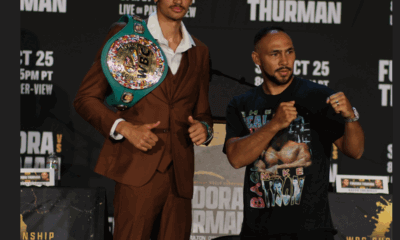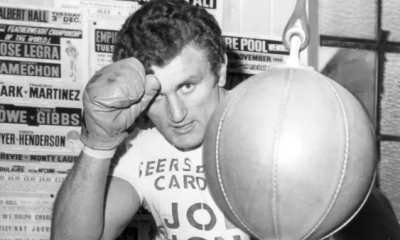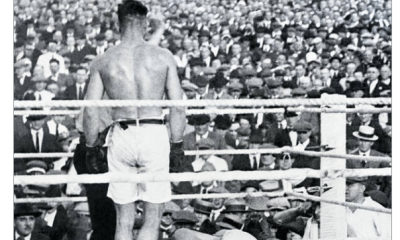Featured Articles
Gerald Sinclair Watches Over the Mayweather Boxing Club, a Las Vegas Landmark
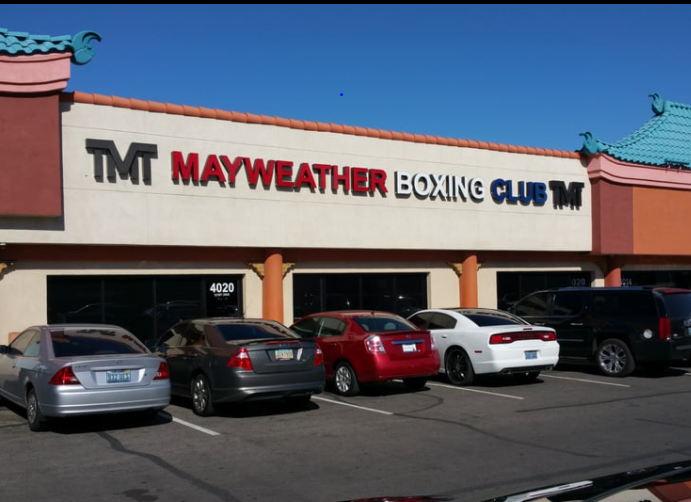
It isn’t a stretch to say that the Mayweather Boxing Club is a Las Vegas landmark. Regardless of one’s feelings toward Floyd — and he certainly has his detractors – the man transcended his sport like no other boxer of recent vintage. According to Forbes, which publishes an annual list of the world’s highest-paid athletes, Floyd Mayweather Jr is one of only three athletes to surpass one billion dollars in career earnings, putting him on the same lofty pedestal as Michael Jordan and Tiger Woods – this despite the fact that Floyd competed in what has been characterized as a dying sport while attracting comparatively little money in commercial endorsements.
The word landmark conveys the thought of an edifice that is architecturally impressive. The Mayweather Boxing Club certainly isn’t that. It sits in a one-story complex of small businesses that take up a full block in an older section of Chinatown which in Las Vegas isn’t a residential neighborhood but an ever-sprawling stretch of Spring Mountain Road that runs west of the Strip for roughly a mile, a string of Asian-owned businesses, predominantly restaurants and massage parlors. The Mayweather gym sits in the back of the complex facing away from the street.
It’s easy to miss it if one is heading there for the first time (it’s helpful to have a car equipped with a GPS locator) but yet tourists often find their way there and that is another defining feature of a landmark.
When entering the gym, it’s likely the first person that one will see is Gerald Sinclair. He co-manages the gym along with his brother John and Cornelius Boza-Edwards, the former world super featherweight champion who engaged in some of the most exciting fights of the 1980s.
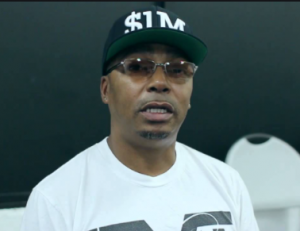
Gerald Sinclair
The Mayweather Boxing Club opened in 2007. Sinclair, 56, was there from the beginning when the facility was roughly half its current size. He grew up in Hudson, New York, a city named for the river that borders the town on the east. Before moving to Las Vegas, he worked as a fork lift driver in a warehouse.
Sinclair was induced to come to Las Vegas by his sister. She is Floyd Mayweather’s mother. Floyd is Gerald’s nephew. It’s all about family at the Mayweather Gym. Floyd’s father of the same name and his uncle Jeff are fixtures there, as was their brother, the late Roger Mayweather, the best of the three fighting Mayweather brothers.
This reporter has never been in a boxing gym that didn’t have colorful posters of old fights tacked to the wall. The Mayweather gym is no exception but all of the oversized posters, all 15 of them, are of Mayweather’s fights. (Needless to say, he won them all.) His face appears on other insignia, including a large banner above a row of folding chairs. There are two regulation-size boxing rings, 11 punching bags of various descriptions clustered in a nook and some of the standard exercise equipment, all indicative of the fact that this is a place to work up a sweat, but the Mayweather Boxing Club is also a little museum of sorts, a paean to the splurgy proprietor who once sported the nickname “Pretty Boy.”
Some boxing gyms – Abel Sanchez’s compound in Big Bear comes quickly to mind – are off-limits to outsiders. The Mayweather Boxing Club is welcoming (which isn’t to say that a busload of fans would be welcome; it wouldn’t).
“When we opened the place,” says Gerald Sinclair, “Floyd came to us and said if fans want to come in and look around, go ahead and let them.”
While we were there the other day, an older man with a Spanish accent appeared in the doorway and sheepishly inquired if he and the people in his party could come inside and give it a quick look-see. “Be my guest,” said Sinclair, whereupon the visitor left and returned with his wife and another couple that he had left waiting in the car.
Sinclair says if the man hadn’t happened to mention that there were other people in his party, that he would have likely brought it up. “We have had guys who came by and left their wife and kids outside in the car and I told them to please invite them in. I know this place is a slice of history. We don’t exclude anyone.”
A tourist giving the gym a gander invariably takes a few selfies and then comes the million-dollar question: “Is he here?” A selfie with Floyd would be a prized souvenir.
No, he’s never there, or almost never there. On the rare occasions when he does pop in during normal business hours, he arrives unannounced, usually with a bodyguard. Floyd Mayweather Jr, who is known to hop in one of his private jets and fly halfway around the world on a whim, lives in a different universe than the denizens of the gym that bears his family name.
Although also rare, a visitor has a better shot of bumping into a celebrity. Eddie Murphy, Christine Aguilera, Maria Carey and P Daddy have walked in the door, as have many prominent athletes including Mike Tyson.
When Tyson appears, it’s old home week for Gerald Sinclair and his brother. During his amateur days and in his early days as a pro, Iron Mike resided in Catskill, living with his trainer Cus D’Amato in the large Victorian home that D’Amato shared with the sister of a sister-in-law. Catskill and Hudson are separated by only 12 miles. Sinclair remembers young Tyson turning up at some of his softball games. Mike made a big hit with the folks running the snack bar, covering the tab of kids hovering around him at the refreshment stand.
A number of boxers from overseas have worked out at the gym while visiting Las Vegas. For some novice boxers, a trip to the Mayweather Boxing Club is a rite of passage. (A stranger in town for a convention or trade show can also use the facility if it isn’t too crowded. There is a day rate for these situations, and the visitor must sign a waiver absolving the club of any liability should he get hurt.)
The Mayweather Boxing Club is now back at full steam after being closed to the general public for several months because of Covid-19. For a time, it was effectively the private gym of Gervonta “Tank” Davis and his team. Everyone who was there while Tank was preparing for his Oct. 31, 2020 date with Leo Santa Cruz, was required to get tested twice a week. There were no hiccups.
“As a boss, Floyd has been very generous to me,” says Sinclair. Thanks to Floyd, he got to see a part of the world that he never would have gotten to see. Floyd invited him along when he flew to Tokyo for his exhibition with Tenshin Nasukawa. Prior to this, Sinclair’s lone trip outside the United States was a trip to Tijuana.
Sinclair has picked up a new skill since leaving New York. He’s frequently the go-to guy when a boxer at the gym needs his hands wrapped. It’s not as simple as it looks, there’s an art to it, and Gerald learned at the feet of the master, Rafael Garcia Sr, who encouraged his interest. Garcia passed away in November of 2017 at age 88, leaving a hole in the hearts of the extended Mayweather family that burned wider when his fellow traveler Roger Mayweather joined him in the afterlife.
The United States has housed several iconic boxing gyms over the years. A short list would include Stillman’s Gym in mid-Manhattan, the Main Street Gym in downtown Los Angeles, the 5th Street Gym in Miami Beach, and the Kronk Gym in Detroit. The Mayweather Boxing Club is destined to eventually join that hallowed roster.
Check out more boxing news on video at the Boxing Channel
To comment on this story in the Fight Forum CLICK HERE
-

 Book Review4 weeks ago
Book Review4 weeks agoMark Kriegel’s New Book About Mike Tyson is a Must-Read
-

 Featured Articles3 weeks ago
Featured Articles3 weeks agoThe Hauser Report: Debunking Two Myths and Other Notes
-
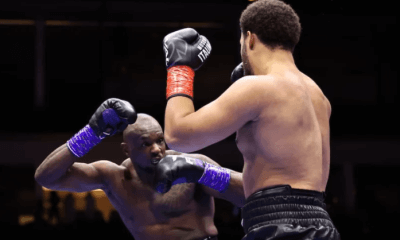
 Featured Articles3 weeks ago
Featured Articles3 weeks agoMoses Itauma Continues his Rapid Rise; Steamrolls Dillian Whyte in Riyadh
-

 Featured Articles3 weeks ago
Featured Articles3 weeks agoNikita Tszyu and Australia’s Short-Lived Boxing Renaissance
-
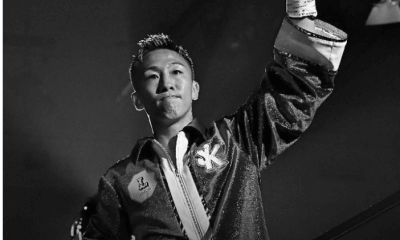
 Featured Articles4 weeks ago
Featured Articles4 weeks agoKotari and Urakawa – Two Fatalities on the Same Card in Japan: Boxing’s Darkest Day
-

 Featured Articles3 weeks ago
Featured Articles3 weeks agoIs Moses Itauma the Next Mike Tyson?
-

 Featured Articles2 weeks ago
Featured Articles2 weeks agoBoxing Odds and Ends: Paul vs ‘Tank,’ Big Trouble for Marselles Brown and More
-

 Featured Articles2 weeks ago
Featured Articles2 weeks agoAvila Perspective, Chap. 340: MVP in Orlando This Weekend


